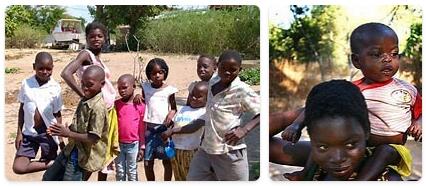
Yearbook 2004
Mozambique. In September, Sweden demanded just over SEK 3.5 million. of Mozambique’s Ministry of Education, after an audit of aid paid showed that the money was used incorrectly. Despite the shortcomings in aid management, the International Monetary Fund (IMF) approved a US $ 16.6 million loan for budget support until 2006.
Despite relatively high inflation of close to 14% in 2003, Mozambique was considered to have managed its economy well by managed to reduce the proportion of poor residents from close to 70% in 1996 to 54% in 2002. GDP was projected to increase by more than 8% in 2004.
The total population in Mozambique is 31,255,446 people in 2020. Mozambique’s biggest political scandal took a new turn in May, when Anibal Antonio dos Santos, alias Anibalzinho, succeeded in escaping from prison where he served a 28-year sentence for the 2000 murder of journalist Carlos Cardoso. He was murdered when he investigated a major banking scandal with suspicious links high up in the political leadership. There were strong suspicions that Anibalzinho was helped to leave the prison, after which he managed to get to Canada. Upon extradition, he was to face a new trial in Mozambique.
In February, Prime Minister Pascoal Mocumbi resigned to take up a new post at an international healthcare program. He was succeeded by 46-year-old Finance Minister Luísa Dias Diogo, Mozambique’s first female prime minister. The appointment of her meant a historic generation shift; she became the first high-level leader to not participate in the liberation war against the Portuguese colonial army.
In the presidential elections in early December, the ruling party won Frelimo’s candidate Armando Guebuza by a large margin. In the parliamentary elections, Frelimo received 160 of the 250 seats. Foreign observers complained about many inaccuracies but judged that the result still reflected the will of the people. However, the opposition party Renamo demanded re-election and threatened to boycott Parliament. Guebuza succeeds Joaquim Chissano, who had to step down after 18 years as president.

Population
The ethnic picture of Mozambique is dominated by the Bantu, within which different groups are distinguished (Makua, Tsonga, Lomwe, Karanga, Sena and others). Alongside the Bantu, in the coastal region live mixed groups derived from crosses between indigenous, Arabs and Indians.
The population of Mozambique increased significantly during the 20th century, passing from about 3 million residents in 1920 to 6.6 million in 1960, and exceeding 20 million at the beginning of the 2nd millennium: an extraordinarily rapid growth (especially in the 1970s and 1980s), whose annual percentage value was around 1.8% in 2009. The distribution of the residents is rather irregular, as the gap between the coastal areas, fairly populated, and the internal ones, is conspicuous. where vast strips of territory are almost uninhabited: the province of Niassa, the largest of the Mozambique, has just 8 residents / km 2. After independence (1975) a large number of residents left the countryside, going to swell the major centers, and especially the capital Maputo (formerly Lourenço Marques), whose population has increased tenfold over the past fifty years. The cities, however, host a total of only 31% of the residents: the traditional settlement, in fact, is represented by agricultural villages, often of minimal size, without the most basic services and difficult to reach because they are far from the communication routes. It is estimated that 70% of the population lives below the poverty line.
The official language is Portuguese, but the population uses Bantu languages extensively. As for religion, the majority practice animist cults; Christians (mainly Catholics) are 24%, Muslims 18%.